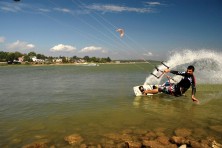Silent Sports Column: Losing Daylight
- Share
- Tweet
- Pin
- Share

On the Thursday night group ride last week, it was the first time this summer that the question of which route we would take was met with, “Well how much sunlight do we have?”
It is inevitable that the days are getting shorter and the nights are getting cooler, but that doesn’t necessarily mean workouts will lose any of their steam. For most of those with traditional nine to five jobs, which is a bit of an anomaly in the service and hospitality world of Door County, this shorter workout time just means you need to take advantage of the inverse relationship of duration and intensity.
This relationship is the hallmark of any endurance training plan and it deals with overall stress. During a workout, you stress your body. When you rest and your body adapts during recovery, you become stronger. There are three things you can increase in your training to increase this overall stress: duration, intensity and frequency.
In training, it is important to increase just one of these variables at a time. For instance, if you are running four times a week for 30 minutes each time at a nine-minute per mile pace, you do not want to start running five times per week for one hour at an eight-minute per mile pace. You have increased all three variables at once and that will create too much stress.
Typically, as duration decreases, intensity increases in this inverse relationship. Less daylight forces a shorter duration, so your evening workouts should be more intense.
On the group rides, this has surely been the case. Where we used to ride between Fish Creek, Baileys Harbor and up to Ellison Bay and back, cycling more than two hours at a moderate pace, we now find ourselves on the road for little more than 90 minutes but pushing a much higher intensity.
Of course, this change from moderate to high intensity will train different body systems, most likely improving strength and muscular endurance instead of your aerobic engine.
On a related note, it is also the time to dust off those bike lights, both front and rear, and reflective clothing to be sure you are visible to cars during twilight hours. Instead of wearing a reflective vest, which will appear unmoving to vehicles, try putting reflective tape on the heels of your cycling shoes. The fast up and down movement of your feet will do a better job of alerting drivers that you are on the road.

